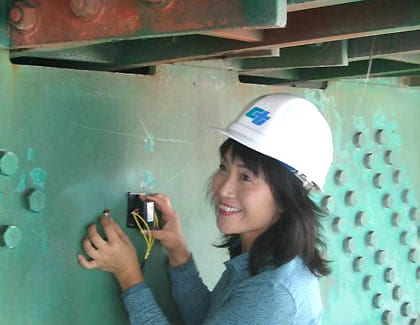Lives in the balance
Engineering professor Maria Feng works to make structures safer and avoid disasters like the Minneapolis bridge collapse

When a heavily traveled interstate bridge collapsed in Minneapolis Aug. 1, Maria Feng, professor of civil and environmental engineering, found herself fielding all kinds of media questions about the tragedy. Feng develops optical fiber sensors to monitor the soundness of bridges and other structures. Now, a topic that once might have interested only structural engineers is on everyone’s minds, and Feng’s work has taken on a new sense of urgency.
Like people, buildings and bridges can suffer the effects of aging, Feng says.
She belongs to a team of researchers at Calit2 and the U.S. Geological Survey who use sophisticated sensors to monitor the structural health of buildings, bridges and other civil infrastructures. She’s measuring the vibration of three Orange County bridges and the Vincent Thomas Bridge in Long Beach. According to the U.S. Department of Transportation’s National Bridge Inventory, 24 Orange County bridges are “structurally deficient,” 16 with ratings equal to or worse than the Minneapolis bridge.
To monitor bridges, Feng is designing fiber-optic sensors – one of which she patented in 1999 – that are smaller, lighter and more resilient to harsh weather conditions than standard electric sensors originally fabricated for mechanical or aerospace systems.
The bridge research, funded by the California Department of Transportation, also employs strain sensors embedded into the concrete, accelerometers, displacement sensors and soil pressure sensors. Data recorders are installed on-site and – in the case of the bridge closest to the university – data are relayed to UCI by point-to-point antennae, and to the Internet, all in real time. The other bridges are too far from UCI to allow such connections, so the research team is creating wireless relay options. Before installing them in the field, Feng tests her sensors in the Calit2 Building’s “living laboratory.”
“We’re constantly testing our new sensors in the building to compare them with traditional sensors,” she says.
Feng has personal reasons for dedicating her career to structural safety. Born and reared in China, she was in high school when the 1976 Tangshan earthquake killed nearly a quarter of a million people.
“It was very shocking,” she says. “Most of the structures in China at that time were masonry buildings that didn’t have much earthquake resistance.” She believes that trauma indirectly led her to her chosen field.
After graduating from Nanjing Institute of Technology with a degree in mechanical engineering, she studied robotics at the University of Tokyo.
“I learned a lot about vibration control and sensors. I began wondering if I could apply the same concepts to the structure system,” she says.
She envisions one day in the not-too-distant future, sensors will be installed in all critical infrastructures. Not only can they help prevent disaster, they can be useful in post-disaster scenarios like closing damaged bridges and overpasses instantly, and rerouting traffic. They’re also cost-efficient, eliminating the need for licensed structural engineers to physically inspect infrastructure for damage after earthquakes.
Before that vision can become reality, Feng says, much work remains.
“With both the hardware and software, we still have a lot of research to do.”
